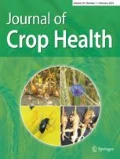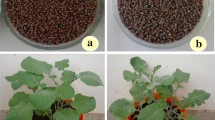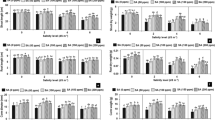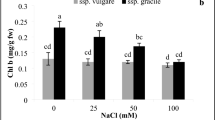Abstract
Soil salinity is one of the ecological problems limiting plant growth and development, especially in semi-arid and arid regions where water availability is very limited. Stevia rebaudiana Bertoni (Asteraceae) is known for its sweetness and non-caloric products (steviol glycosides). It can be considered as a plant for the future sugar industry and human health nutrition. The present work aims to study the modulation of salt stress (NaCl: 80 mM) effects on Stevia rebaudiana Bertoni plants by an exogenous application of salicylic acid (0 mM, 0.1 mM and 0.5 mM). The results obtained show that saline stress influences the growth and development of the plant through several metabolism aspects. The exogenous application of salicylic acid to plants subjected to saline stress has improved plant biomass, chlorophyll content, chlorophyll fluorescence, stomatal conductance, antioxidant enzyme activity, MDA content and electrolyte leakage. All these results show a potential role of salicylic acid in strengthening tolerance mechanisms and mitigating physiological and biochemical damage caused by saline stress on Stevia rebaudiana Bertoni plant.
Zusammenfassung
Die Versalzung des Bodens ist eines der ökologischen Probleme, die das Wachstum und die Entwicklung von Pflanzen einschränken, besonders in semi-ariden und ariden Regionen, in denen die Wasserverfügbarkeit sehr begrenzt ist. Stevia rebaudiana Bertoni (Asteraceae) ist bekannt für ihre Süße und nichtkalorischen Produkte (Steviolglykoside). Sie kann als Pflanze für die künftige Zuckerindustrie und die gesunde Ernährung betrachtet werden. Die vorliegende Arbeit zielt darauf ab, die Modulation der Effekte von Salzstress (NaCl: 80 mM) auf Stevia rebaudiana Bertoni-Pflanzen durch eine exogene Applikation von Salicylsäure (0 mM, 0,1 mM und 0,5 mM) zu untersuchen. Die erzielten Ergebnisse zeigen, dass Salzstress das Wachstum und die Entwicklung der Pflanze durch verschiedene Stoffwechselaspekte beeinflusst. Die exogene Anwendung von Salicylsäure auf Pflanzen, die Salzstress ausgesetzt waren, hat die Pflanzenbiomasse, den Chlorophyllgehalt, die Chlorophyllfluoreszenz, die stomatäre Leitfähigkeit, die antioxidative Enzymaktivität, den MDA-Gehalt und den Elektrolytverlust verbessert. All diese Ergebnisse zeigen eine potenzielle Rolle von Salicylsäure bei der Stärkung von Toleranzmechanismen und der Abschwächung von physiologischen und biochemischen Schäden, die durch Salzstress an der Stevia rebaudiana Bertoni-Pflanze verursacht werden.














Similar content being viewed by others
References
Ahanger MA, Agarwal RM (2017) Salinity stress induced alterations in antioxidant metabolism and nitrogen assimilation in wheat (Triticum aestivum L) as influenced by potassium supplementation. Plant Physiol Biochem 115:449–460
Ahmad P, Alyemeni MN, Ahanger MA, Egamberdieva D, Wijaya L, Alam P (2018) Salicylic acid (SA) induced alterations in growth, biochemical attributes and antioxidant enzyme activity in faba bean (Vicia faba L.) seedlings under NaCl toxicity. Russ J Plant Physiol 65(1):104–114. https://doi.org/10.1134/S1021443718010132
Alsahli A, Mohamed AK, Alaraidh I, Al-Ghamdi A, Al-Watban A, El-Zaidy M, Alzahrani SM (2019) Salicylic acid alleviates salinity stress through the modulation of biochemical attributes and some key antioxidants in wheat seedlings. Pak J Bot 51(5):1551–1559. https://doi.org/10.30848/PJB2019-5(12)
Anaya F, Fghire R, Wahbi S, Loutfi K (2017) Antioxidant enzymes and physiological traits of Vicia faba L. as affected by salicylic acid under salt stress. J Mater Environ Sci 8(7):2549–2563
Arif Y, Singh P, Siddiqui H, Bajguz A, Hayat S (2020) Salinity induced physiological and biochemical changes in plants: an omic approach towards salt stress tolerance. Plant Physiol Biochem 156:64–77. https://doi.org/10.1016/j.plaphy.2020.08.042
Arnon DI (1949) Copper enzymes in isolated chloroplasts. Polyphenoloxidase in Beta vulgaris. Plant Physiol 24(1):1
Astaneh RK, Bolandnazar S, Nahandi FZ, Oustan S (2019) Effects of selenium on enzymatic changes and productivity of garlic under salinity stress. S Afr J Bot 121:447–455. https://doi.org/10.1016/j.sajb.2018.10.037
Batista VCV, Pereira IMC, de Oliveira Paula-Marinho S, Canuto KM, Pereira RDCA, Rodrigues THS et al (2019) Salicylic acid modulates primary and volatile metabolites to alleviate salt stress-induced photosynthesis impairment on medicinal plant Egletes viscosa. Environ Exp Bot 167:103870. https://doi.org/10.1016/j.envexpbot.2019.103870
Beauchamp C, Fridovich I (1971) Superoxide dismutase: improved assays and an assay applicable to acrylamide gels. Anal Biochem 44(1):90370–90378. https://doi.org/10.1016/0003-2697
Bose J, Munns R, Shabala S, Gilliham M, Pogson B, Tyerman SD (2017) Chloroplast function and ion regulation in plants growing on saline soils: lessons from halophytes. J Exp Bot 68(12):3129–3143. https://doi.org/10.1093/jxb/erx142
Bradford MM (1976) A rapid and sensitive method for the quantitation of microgram quantities of protein utilizing the principle of protein-dye binding. Anal Biochem 72(1–2):248–254. https://doi.org/10.1016/0003-2697(76)90527-3
Bukhat S, Manzoor H, Zafar ZU, Azeem F, Rasul S (2020) Salicylic acid induced photosynthetic adaptability of raphanus sativus to salt stress is associated with antioxidant capacity. J Plant Growth Regul 39(2):809–822. https://doi.org/10.1007/s00344-019-10024-z
Cantabella D, Piqueras A, Acosta-Motos JR, Bernal-Vicente A, Hernández JA, Díaz-Vivancos P (2017) Salt-tolerance mechanisms induced in stevia rebaudiana Bertoni: effects on mineral nutrition, antioxidative metabolism and steviol glycoside content. Plant Physiol Biochem 115:484–496. https://doi.org/10.1016/j.plaphy.2017.04.023
El-Esawi MA, Elansary HO, El-Shanhorey NA, Abdel-Hamid AM, Ali HM, Elshikh MS (2017) Salicylic acid-regulated antioxidant mechanisms and gene expression enhance rosemary performance under saline conditions. Front Physiol 8:716. https://doi.org/10.3389/fphys.2017.00716
Fardus J, Matin MA, Hasanuzzaman M, Hossain MA, Hasanuzzaman M (2018) Salicylic acid-induced improvement in germination and growth parameters of wheat under salinity stress. J Anim Plant Sci 28:197–207
Gerami M, Majidian P, Ghorbanpour A, Alipour Z (2020) Stevia rebaudiana Bertoni responses to salt stress and chitosan elicitor. Physiol Mol Biol Plants. https://doi.org/10.1007/s12298-020-00788-0
Ghaderi N, reza Hatami M, Mozafari A, Siosehmardeh A (2018) Change in antioxidant enzymes activity and some morpho-physiological characteristics of strawberry under long-term salt stress. Physiol Mol Biol Plants 24(5):833–843. https://doi.org/10.1007/s12298-018-0535-2
Ghanem ME, Albacete A, Martínez-Andújar C, Acosta M, Romero-Aranda R, Dodd IC, Pérez-Alfocea F (2008) Hormonal changes during salinity-induced leaf senescence in tomato (Solanum lycopersicum L.). J Exp Bot 59(11):3039–3050. https://doi.org/10.1093/jxb/ern153
Gunes A, Inal A, Alpaslan M, Eraslan F, Bagci EG, Cicek N (2007) Salicylic acid induced changes on some physiological parameters symptomatic for oxidative stress and mineral nutrition in maize (Zea mays L.) grown under salinity. J Plant Physiol 164(6):728–736. https://doi.org/10.1016/j.jplph.2005.12.009
Hniličková H, Hnilička F, Orsák M, Hejnák V (2019) Effect of salt stress on growth, electrolyte leakage, Na+ and K+ content in selected plant species. Plant Soil Environ 65(2):90–96. https://doi.org/10.17221/620/2018-PSE
Hoagland DR, Arnon DI (1950) The water-culture method for growing plants without soil. Circular. California agricultural experiment station, 347, 2nd edn.
Hori K, Wada A, Shibuta T (1997) Changes in phenoloxidase activities of the galls on leaves of Ulmus davidana formed by Tetraneura fuslformis (Homoptera: Eriosomatidae). Appl Entomol Zool 32(2):365–371. https://doi.org/10.1303/aez.32.365
Jahan MS, Wang Y, Shu S, Zhong M, Chen Z, Wu J, Guo S (2019) Exogenous salicylic acid increases the heat tolerance in Tomato (Solanum lycopersicum L) by enhancing photosynthesis efficiency and improving antioxidant defense system through scavenging of reactive oxygen species. Sci Hortic 247:421–429. https://doi.org/10.1016/j.scienta.2018.12.047
Jini D, Joseph B (2017) Physiological mechanism of salicylic acid for alleviation of salt stress in rice. Rice Sci 24(2):97–108. https://doi.org/10.1016/j.rsci.2016.07.007
Kalhor MS, Aliniaeifard S, Seif M, Asayesh EJ, Bernard F, Hassani B, Li T (2018) Enhanced salt tolerance and photosynthetic performance: Implication of ɤ‑amino butyric acid application in salt-exposed lettuce (Lactuca sativa L.) plants. Plant Physiol Biochem 130:157–172. https://doi.org/10.1016/j.plaphy.2018.07.003
Kapoor RT, Hasanuzzaman M (2020) Exogenous kinetin and putrescine synergistically mitigate salt stress in Luffa acutangula by modulating physiology and antioxidant defense. Physiol Mol Biol Plants. https://doi.org/10.1007/s12298-020-00894-z
Karlidag H, Yildirim E, Turan M (2009) Salicylic acid ameliorates the adverse effect of salt stress on strawberry. Sci Agric 66(2):180–187. https://doi.org/10.1590/S0103-90162009000200006
Kaya C, Ashraf M, Alyemeni MN, Ahmad P (2020) The role of endogenous nitric oxide in salicylic acid-induced up-regulation of ascorbate-glutathione cycle involved in salinity tolerance of pepper (Capsicum annuum L.) plants. Plant Physiol Biochem 147:10–20. https://doi.org/10.1016/j.plaphy.2019.11.040
Kaya C, Aydemir S, Akram NA, Ashraf M (2018) Epibrassinolide application regulates some key physio-biochemical attributes as well as oxidative defense system in maize plants grown under saline stress. J Plant Growth Regul 37(4):1244–1257. https://doi.org/10.1007/s00344-018-9830-y
Khan MIR, Fatma M, Per TS, Anjum NA, Khan NA (2015) Salicylic acid-induced abiotic stress tolerance and underlying mechanisms in plants. Front Plant Sci 6:462. https://doi.org/10.3389/fpls.2015.00462
Khator K, Mahawar L, Shekhawat GS (2020) NaCl induced oxidative stress in legume crops of Indian Thar Desert: an insight in the cytoprotective role of HO1, NO and antioxidants. Physiol Mol Biol Plants 26(1):51–62. https://doi.org/10.1007/s12298-019-00728-7
Lotfi R, Ghassemi-Golezani K, Pessarakli M (2020) Salicylic acid regulates photosynthetic electron transfer and stomatal conductance of mung bean (Vigna radiata L.) under salinity stress. Biocatal Agric Biotechnol. https://doi.org/10.1016/j.bcab.2020.101635
Ma X, Zheng J, Zhang X, Hu Q, Qian R (2017) Salicylic acid alleviates the adverse effects of salt stress on dianthus superbus (caryophyllaceae) by activating photosynthesis, protecting morphological structure, and enhancing the antioxidant system. Front Plant Sci 8:600. https://doi.org/10.3389/fpls.2017.00600
Mahajan M, Sharma S, Kumar P, Pal PK (2020) Foliar application of KNO3 modulates the biomass yield, nutrient uptake and accumulation of secondary metabolites of Stevia rebaudiana under saline conditions. Ind Crops Prod 145:112102
Mahlooji M, Sharifi RS, Razmjoo J, Sabzalian MR, Sedghi M (2018) Effect of salt stress on photosynthesis and physiological parameters of three contrasting barley genotypes. Photosynthetica 56(2):549–556. https://doi.org/10.1007/s11099-017-0699-y
Mehta P, Jajoo A, Mathur S, Bharti S (2010) Chlorophyll a fluorescence study revealing effects of high salt stress on photosystem II in wheat leaves. Plant Physiol Biochem 48(1):16–20. https://doi.org/10.1016/j.plaphy.2009.10.006
Methenni K, Abdallah MB, Nouairi I, Smaoui A, Zarrouk M, Youssef NB (2018) Salicylic acid and calcium pretreatments alleviate the toxic effect of salinity in the oueslati olive variety. Sci Hortic 233:349–358
Miao Y, Luo X, Gao X, Wang W, Li B, Hou L (2020) Exogenous salicylic acid alleviates salt stress by improving leaf photosynthesis and root system architecture in cucumber seedlings. Sci Hortic 272:109577
Mimouni H, Wasti S, Manaa A, Gharbi E, Chalh A, Vandoorne B, Ahmed HB (2016) Does salicylic acid (SA) improve tolerance to salt stress in plants? A study of SA effects on tomato plant growth, water dynamics, photosynthesis, and biochemical parameters. OMICS 20(3):180–190. https://doi.org/10.1089/omi.2015.0161
Montavon P, Kukic KR, Bortlik K (2007) A simple method to measure effective catalase activities: optimization, validation, and application in green coffee. Anal Biochem 360(2):207–215. https://doi.org/10.1016/j.ab.2006.10.035
Mutlu S, Atıcı Ö, Nalbantoğlu B, Mete E (2016) Exogenous salicylic acid alleviates cold damage by regulating antioxidative system in two barley (Hordeum vulgare L.) cultivars. Front Life Sci 9(2):99–109. https://doi.org/10.1080/21553769.2015.1115430
Nazar R, Iqbal N, Syeed S, Khan NA (2011) Salicylic acid alleviates decreases in photosynthesis under salt stress by enhancing nitrogen and sulfur assimilation and antioxidant metabolism differentially in two mungbean cultivars. J Plant Physiol 168(8):807–815. https://doi.org/10.1016/j.jplph.2010.11.001
Oktay M, Küfreviolu I, Kocaçalişkan I, Şaklrolu H (1995) Polyphenoloxidase from Amasya apple. J Food Science 60(3):494–496. https://doi.org/10.1111/j.1365-2621.1995.tb09810.x
Ordóñez YBM, Jaramillo GR, Chalé JT (2018) Efecto de la calidad del agua y sustratos en la producción de plántulas de estevia („Stevia rebaudiana” Bertoni). Rev Mex Cienc Agríc 21:4284–4295
Radhouane L (2008) Salinity effect on germination, growth, and grain production of some autochthonous pear millet ecotypes (Pennisetum glaucum (L.) R. Br.). C R Biol 331(4):278–286. https://doi.org/10.1016/j.crvi.2008.01.006
Rasool S, Ahmad A, Siddiqi TO, Ahmad P (2013) Changes in growth, lipid peroxidation and some key antioxidant enzymes in chickpea genotypes under salt stress. Acta Physiol Plant 35(4):1039–1050
Sabzmeydani E, Sedaghathoor S, Hashemabadi D (2020) Progesterone and salicylic acid elevate tolerance of Poa pratensis to salinity stress. Russ J Plant Physiol 67(2):285–293. https://doi.org/10.1134/S1021443720020132
Samuel P, Ayoob KT, Magnuson BA, Wölwer-Rieck U, Jeppesen PB, Rogers PJ, Mathews R (2018) Stevia leaf to stevia sweetener: exploring its science, benefits, and future potential. J Nutr 148(7):1186S–1205S. https://doi.org/10.1093/jn/nxy102
Santos JB, Gheyi HR, de Lima GS, Xavier DA, Cavalcante LF, Centeno CRM (2016) Morfofisiologia e produção do algodoeiro herbáceo irrigado com águas salinas eadubado com nitrogênio. Comun Sci 7(1):86–96. https://doi.org/10.14295/cs.v7i1.1158
Schulze ED, Hall AE (1982) Stomatal responses, water loss and CO 2 assimilation rates of plants in contrasting environments. In: Physiological plant ecology II. Springer, Berlin, Heidelberg, New York, pp 181–230 https://doi.org/10.1007/978-3-642-68150-9_8
Shakirova FM, Allagulova CR, Maslennikova DR, Klyuchnikova EO, Avalbaev AM, Bezrukova MV (2016) Salicylic acid-induced protection against cadmium toxicity in wheat plants. Environ Exp Bot 122:19–28. https://doi.org/10.1016/j.envexpbot.2015.08.002
Sharma M, Gupta SK, Majumder B, Maurya VK, Deeba F, Alam A, Pandey V (2018) Proteomics unravel the regulating role of salicylic acid in soybean under yield limiting drought stress. Plant Physiol Biochem 130:529–541. https://doi.org/10.1016/j.plaphy.2018.08.001
Shivanna N, Naika M, Khanum F, Kaul VK (2013) Antioxidant, anti-diabetic and renal protective properties of Stevia rebaudiana. J Diabetes Complicat 27(2):103–113. https://doi.org/10.1016/j.jdiacomp.2012.10.001
Simaei M, Khafari Nejad RA, Bernard F (2012) Exogenous application of salycilic acidand nitric oxide on the ionic contents and enzymatic activities in NaCl-stressed soybean plants. Am J Plant Sci 3:1495–1503
Soliman WS, El-Shaieny AAH (2014) Effect of saline water on germination and early growth stage of five Apiaceae species. Afr J Agric Res 9:713–719
Souana K, Taïbi K, Abderrahim LA, Amirat M, Achir M, Boussaid M, Mulet JM (2020) Salt-tolerance in Vicia faba L. is mitigated by the capacity of salicylic acid to improve photosynthesis and antioxidant response. Sci Hortic 273:109641
Srivastava M, Shahi S (2018) Effect of salinity on morpho-physiological aspects, antioxidant enzymatic studies and yield attributes in wheat genotypes. Plant Physiol Rep 23(2):385–392. https://doi.org/10.1007/s40502-018-0375-7
Syeed S, Anjum NA, Nazar R, Iqbal N, Masood A, Khan NA (2011) Salicylic acid-mediated changes in photosynthesis, nutrients content and antioxidant metabolism in two mustard (Brassica juncea L.) cultivars differing in salt tolerance. Acta Physiol Plant 33(3):877–886. https://doi.org/10.1007/s11738-010-0614-7
Tahjib-Ul-Arif M, Siddiqui MN, Sohag AAM, Sakil MA, Rahman MM, Polash MAS, Tran LSP (2018) Salicylic acid-mediated enhancement of photosynthesis attributes and antioxidant capacity contributes to yield improvement of maize plants under salt stress. J Plant Growth Regul 37(4):1318–1330. https://doi.org/10.1007/s00344-018-9867-y
Turner NC, Begg JE (1981) Plant-water relations and adaptation to stress. Plant Soil 58(1–3):97–131. https://doi.org/10.1007/BF02180051
Valentovic P, Luxova M, Kolarovic L, Gasparikova O (2006) Effect of osmotic stress on compatible solutes content, membrane stability and water relations in two maize cultivars. Plant Soil Environ 52(4):184
Velikova V, Yordanov I, Edreva A (2000) Oxidative stress and some antioxidant systems in acid rain-treated bean plants: protective role of exogenous polyamines. Plant Sci 151(1):59–66. https://doi.org/10.1016/S0168-9452(99)00197-1
Vighi IL, Benitez LC, Amaral MN, Moraes GP, Auler PA, Rodrigues GS, Braga EJB (2017) Functional characterization of the antioxidant enzymes in rice plants exposed to salinity stress. Biol Plant 61(3):540–550. https://doi.org/10.1007/s10535-017-0727-6
Yin D, Chen S, Chen F, Guan Z, Fang W (2009) Morphological and physiological responses of two chrysanthemum cultivars differing in their tolerance to waterlogging. Environ Exp Bot 67(1):87–93. https://doi.org/10.1016/j.envexpbot.2009.06.006
Zeng J, Chen A, Li D, Yi B, Wu W (2013) Effects of salt stress on the growth, physiological responses, and glycoside contents of Stevia rebaudiana Bertoni. J Agric Food Chem 61(24):5720–5726. https://doi.org/10.1021/jf401237x
Zhang T, Hu Y, Zhang K, Tian C, Guo J (2018) Arbuscular mycorrhizal fungi improve plant growth of Ricinus communis by altering photosynthetic properties and increasing pigments under drought and salt stress. Ind Crops Prod 117:13–19. https://doi.org/10.1016/j.indcrop.2018.02.087
Zhao HJ, Zhao XJ, Ma PF, Wang YX, Hu WW, Li LH, Zhao YD (2011) Effects of salicylic acid on protein kinase activity and chloroplast D1 protein degradation in wheat leaves subjected to heat and high light stress. Acta Ecol Sin 31(5):259–263. https://doi.org/10.1016/j.chnaes.2011.06.006
Zhu JK (2001) Plant salt tolerance. Trends Plant Sci 6(2):66–71. https://doi.org/10.1016/S1360-1385(00)01838-0
Author information
Authors and Affiliations
Corresponding author
Ethics declarations
Conflict of interest
I. Janah, A. Elhasnaoui, O. Issa Ali, K. Lamnai, S. Aissam and K. Loutfi declare that they have no competing interests.
Rights and permissions
About this article
Cite this article
Janah, I., Elhasnaoui, A., Issa Ali, O. et al. Physiochemical Responses of Stevia rebaudiana Bertoni Subjected to Sodium Chloride (NaCl) Salinity and Exogenous Salicylic Acid Application. Gesunde Pflanzen 73, 509–520 (2021). https://doi.org/10.1007/s10343-021-00570-6
Received:
Accepted:
Published:
Issue Date:
DOI: https://doi.org/10.1007/s10343-021-00570-6




